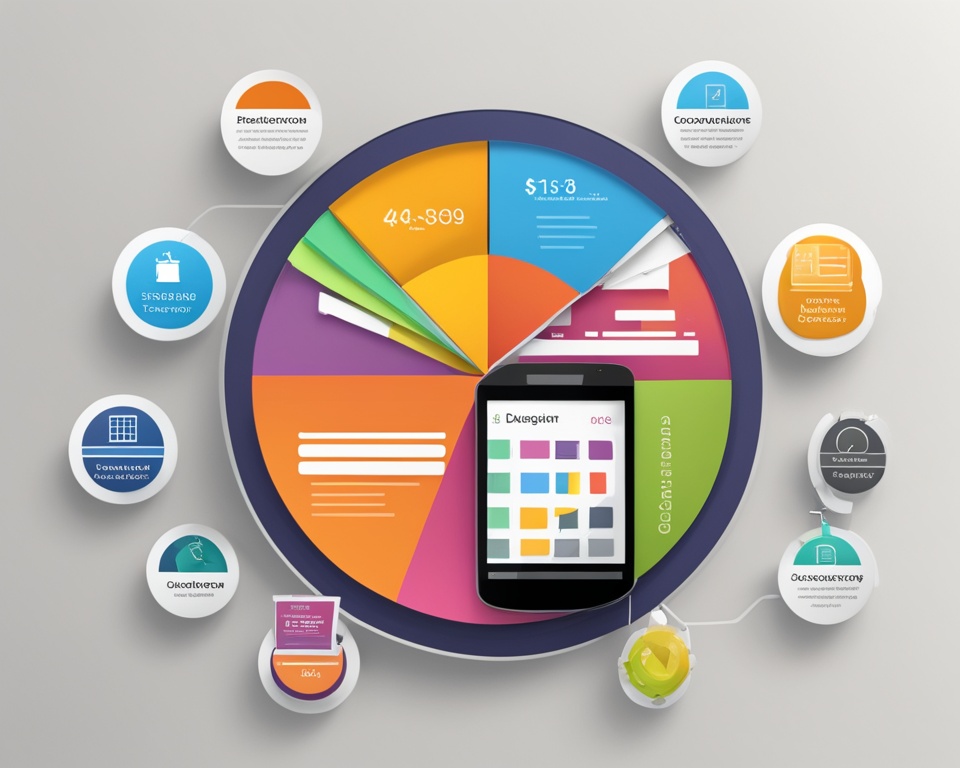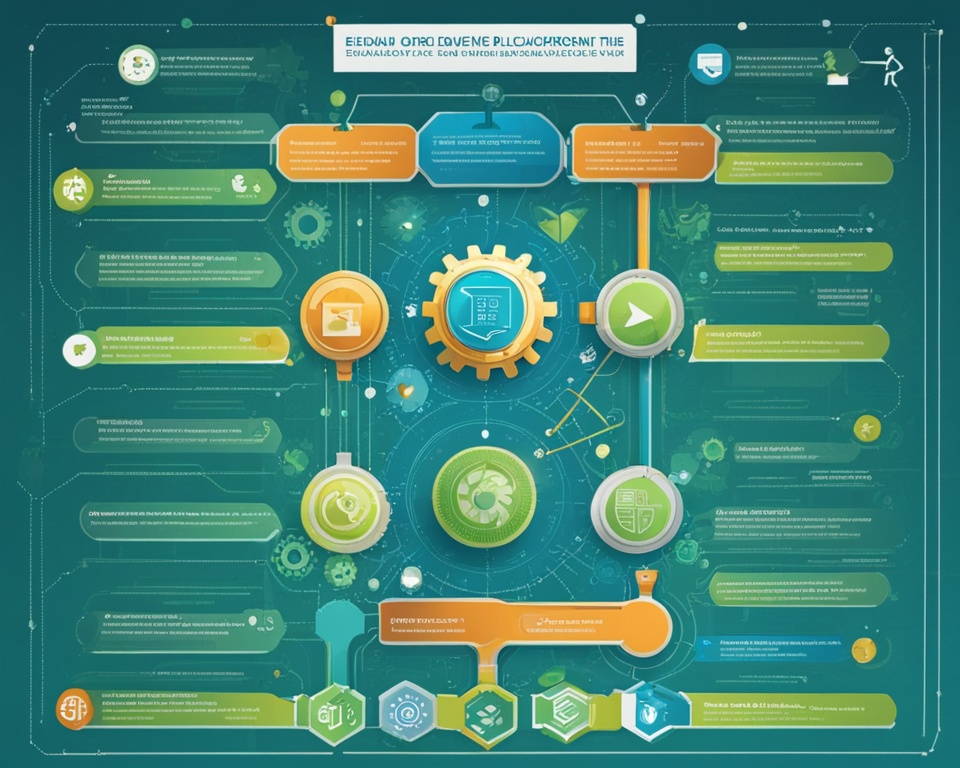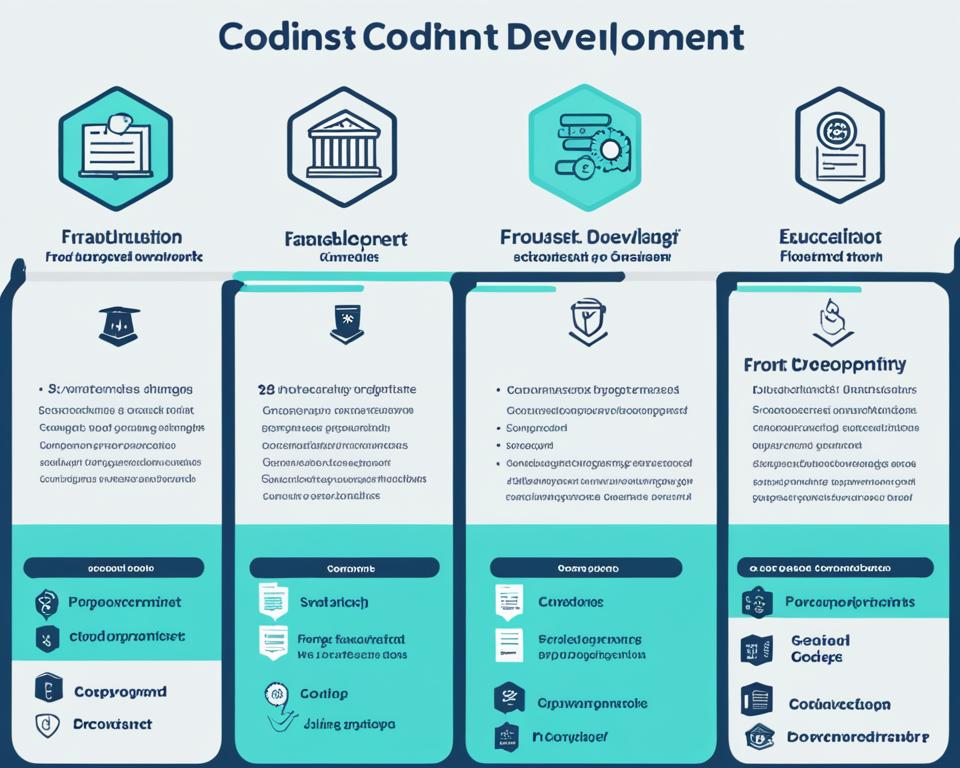In today’s digital age, the demand for innovative education apps has skyrocketed. Developing an education-focused mobile application can be complex and costly. The price tag varies widely due to several factors. This article will explore the cost to develop an education app. It will look at what makes the price go up and how to manage costs and get a good return on investment (ROI).
Table of Contents
Key Takeaways
- The cost to develop an education app can range from $25,000 to $250,000, depending on the complexity and features.
- Factors such as app features, platform compatibility, and the development process stages impact the overall cost.
- Hiring an experienced app development team, integrating third-party APIs, and ensuring thorough testing are essential considerations.
- Ongoing maintenance and support costs are crucial for the long-term success of an education app.
- Implementing cost-saving strategies, like minimizing scope and leveraging existing resources, can help optimize the development budget.
Introduction to Education App Development Costs
Creating an engaging education app is a big step, with costs that change a lot. These costs depend on the project’s complexity, features, and how it’s made. Knowing what affects the education app development budget is key. It helps set realistic goals and plan a successful launch.
When looking at education app pricing, think about who will use the app. Apps for kids, language learners, or adults need different features and resources. The cost factors for education apps also include the user interface’s complexity, multimedia, and how interactive and fun the app is.
| Key Cost Factors | Description |
|---|---|
| Platform Compatibility | Developing for multiple platforms, like iOS and Android, can greatly affect the budget. |
| Third-Party Integrations | Adding features like payment systems, user login, or learning tools can increase costs. |
| Ongoing Maintenance | Regular updates, bug fixes, and security updates are crucial for an app’s success. They need a budget for maintenance and support. |
By thinking about these factors and planning well, organizations can make a detailed budget for education app development. This budget should match their goals and help ensure a successful launch.
“Investing in the right education app development strategy can pay dividends in terms of user engagement, learning outcomes, and long-term sustainability.”
Factors Influencing Education App Development Costs
Creating a top-notch education app means looking at many factors that affect its cost. Things like the app’s features and how it works, as well as the platforms and devices it supports, are key to the budget.
App Features and Functionality
The features and what the app can do greatly affect its cost. Things like the type of content, how interactive it is, and if it includes videos or animations can make it pricier.
An app with lots of interactive learning modules, personalized tests, and ways for students to work together will cost more to make. This is because it needs more time and resources.
Platform and Device Compatibility
Which platforms and devices the app works on also changes its cost. Making an app work on both iOS and Android, or on phones, tablets, and laptops, makes it more complex and expensive.
| Platform | Estimated Development Cost |
|---|---|
| iOS | $25,000 – $50,000 |
| Android | $20,000 – $45,000 |
| Cross-Platform (iOS and Android) | $35,000 – $70,000 |
The table shows a rough idea of what it might cost to make an education app for different platforms. But, the real cost can change based on the app’s needs and how complex the project is.
Cost to Develop an Education App
Creating an education app can be a big investment. The cost depends on the app’s features, complexity, and how it’s made. The average cost of education app development is usually between $25,000 and $100,000. This cost can go even higher or lower.
The pricing for education app projects changes based on several things, like:
- The number and complexity of the app’s features
- The choice of platforms (iOS, Android, or both)
- The level of customization and design needed
- The use of third-party APIs and services
- The need for backend development and database integration
- The level of testing and quality assurance needed
Let’s look at a hypothetical example to understand costs better:
| Feature | Estimated Cost |
|---|---|
| Basic app structure and navigation | $10,000 – $20,000 |
| Interactive educational content (e.g., lessons, quizzes, games) | $15,000 – $30,000 |
| User management and profiles | $5,000 – $10,000 |
| Progress tracking and reporting | $8,000 – $15,000 |
| Push notifications and in-app messaging | $5,000 – $10,000 |
| Integration with third-party APIs (e.g., payment gateways, LMS) | $10,000 – $20,000 |
| Backend server and database setup | $10,000 – $20,000 |
| Thorough testing and quality assurance | $5,000 – $10,000 |
These figures are based on what’s typical in the industry. But, your app’s specific needs might change these costs. It’s key to team up with a skilled app development team. They can give you a clear idea of what your project will cost and help you plan your budget.
Understanding the App Development Process
Creating an education app is a complex task that covers many steps. It starts with planning and research and moves on to detailed design and prototyping. Each step is vital for the app’s final form. Knowing this process helps estimate the costs of making an education app.
Planning and Research
The first step is thorough planning and research. This stage sets the project’s foundation. It defines the app’s goals, who it’s for, and its main features. Market analysis, user research, and looking at competitors help pinpoint the app’s unique selling points. It makes sure the app meets the needs of its users.
Design and Prototyping
After planning, the focus moves to designing and prototyping the app. This means making wireframes, mockups, and interactive prototypes to show how the app will look and work. Through design cycles and user testing, the design gets better. It becomes more user-friendly and meets the app’s goals.
The process of making an education app is detailed and careful. Each step adds to the project’s cost. By understanding this process, developers can plan for the expenses of their digital projects.
Hiring an App Development Team
Choosing whether to build an in-house team or outsource your project is a big decision. This choice affects the cost, timeline, and quality of your education app.
In-House vs. Outsourcing
Building an app with your own team gives you more control and customization. But, it means spending a lot on hiring, training, and managing a skilled team. Outsourcing can save money, bring in specialized skills, and get your app to market faster.
When deciding between in-house and outsourced teams, think about these points:
- Expertise: Look at the in-house team’s experience or check the outsourcing partner’s track record.
- Cost: Compare the costs of an in-house team with the rates of an outsourced provider.
- Timeline: See how long it takes to build an in-house team versus outsourcing timelines.
- Scalability: Think about how easy it is to grow your development efforts, whether with an in-house team or an outsourced partner.
- Communication and Collaboration: Consider how easy it is to talk and work together with an in-house team versus a remote partner.
By thinking about these factors, you can make a choice that fits your goals, budget, and timeline for your education app.
Cost Breakdown: Front-End Development
The front-end development of an education app is key. It includes the user interface and user experience (UI/UX). This part greatly affects the total cost. Knowing what affects the cost helps you plan and budget your project well.
Factors Affecting Front-End Development Costs for Education Apps
- Design Complexity: The app’s visual design and user interface complexity affect costs. Complex designs with custom animations and interactive elements cost more.
- Responsive Design: Making the app work well on phones, tablets, and computers is important. This can increase costs.
- Accessibility Features: Adding features like screen readers and high-contrast modes makes the app more inclusive. But, it also costs more.
- Third-Party Integrations: Working with external APIs or services can make development harder and more expensive.
Knowing what affects front-end development cost for education apps helps you plan better. This is key for your education app project.
| Factor | Impact on Front-End Development Costs |
|---|---|
| Design Complexity | Higher complexity leads to increased costs |
| Responsive Design | Optimizing for multiple devices adds to expenses |
| Accessibility Features | Enhancing inclusivity increases development costs |
| Third-Party Integrations | Integrating external services raises front-end development costs |
Thinking about these factors affecting front-end development costs for education apps helps you plan your budget better.
“Investing in a well-designed and user-friendly front-end can significantly enhance the overall success and engagement of your education app.”
Cost Breakdown: Back-End Development
The back-end of an education app is just as crucial as the front-end for user experience. It includes the server infrastructure, databases, and APIs. These components greatly affect the back-end development cost for education apps. Knowing what influences these costs helps with budgeting and planning an education app project.
Server and Database Setup
The costs for server and database setup for education apps can change a lot. The hosting platform, server specs, and database design all play a part. The number of users, data volume, and security needs also affect the factors affecting back-end development costs for education apps.
Let’s look at the main things that change the back-end development costs:
- Hosting platform: Choosing between cloud solutions (AWS, Google Cloud, Microsoft Azure) or a dedicated server changes costs.
- Server specifications: The server’s power, memory, and storage decide its cost.
- Database complexity: The database’s size, structure, and table number influence setup and maintenance costs.
- Security measures: Adding strong security like SSL/TLS encryption, firewalls, and backups increases costs.
- Scalability: Making sure the back-end can handle more users and data requires extra investment.
By looking at these factors and matching the back-end with the app’s needs, businesses can lower the back-end development cost for education apps. This ensures a dependable and scalable solution for their education app.
Cost of Third-Party Integrations and APIs
When making an education app, the cost of working with other services is key. These services, like payment gateways, analytics tools, or content providers, are vital for a full app experience. The cost of third-party integrations for education apps changes a lot, based on how complex the integration is and what services you need.
The API integration costs for education apps are also big to think about. APIs let your app talk to other systems, adding lots of functionality and data. Setting up APIs can mean fees for setup, charges based on how much you use them, and time for developers to make it work.
Things that affect the cost of these integrations include how many you need, how hard they are to set up, the prices of the services, and the time and resources needed to keep them running. Knowing these costs is key when planning your app’s budget.
“Integrating with other services can cost a lot, but it can also bring big benefits to your education app. Make sure to look at the costs and see how they match up with the value these integrations add.”
By planning and budgeting for the cost of third-party integrations for education apps and API integration costs, you can keep your app project on track. This way, you make sure your app has the features and functionality your users want.
Testing and Quality Assurance Costs
Testing and quality assurance (QA) are key for education app success. They ensure the app works well, performs well, and meets user needs. But, these costs can be a big part of the budget.
Importance of Thorough Testing
Education apps aim to improve learning. So, they must work perfectly. Testing finds and fixes bugs, makes the app run smoothly, and keeps users happy. This leads to more users and success in the market.
The cost of testing and QA depends on the app’s complexity, the platforms it runs on, and the testing methods used. Factors that affect costs include:
- Scope and complexity of the app’s features and functionality
- Number of platforms and devices that need to be tested
- Testing approaches (manual, automated, or a combination)
- Extent of user testing and feedback incorporation
- Compliance with industry standards and regulations
To keep testing costs down, developers should plan carefully and use both manual and automated testing. This approach finds problems early, leading to a better final product.
“Thorough testing is not just about finding bugs – it’s about ensuring the app delivers a seamless and engaging learning experience for users.”
By investing in detailed testing and QA, developers can avoid costly problems after launch. This improves the app’s quality and boosts its chances of success.
App Store Publishing and Deployment Costs
Creating an education app is just the start. After it’s ready, you’ll face more costs to publish and deploy it on app stores like the Apple App Store or Google Play. These app store submission and deployment costs for education apps can greatly affect your app’s budget.
Several things can change the cost of publishing education apps, such as:
- App store fees and commissions
- Localization and translation costs for international distribution
- Compliance and security requirements
- Promotional activities and app store optimization
Knowing these factors affecting app publishing costs for education apps is key to planning your app’s launch and budgeting for success.
“Navigating the app store submission and deployment process can be daunting, but it’s a necessary step to ensure your education app reaches its target audience.”
By doing your homework, budgeting well, and working with experts, you can make the publishing and deployment smoother. This way, you can make your education app more effective.
Ongoing Maintenance and Support Costs
Creating an education app is just the start. Keeping it running well is key to its success. The costs for maintaining and supporting an education app can add up fast. But, they’re vital to keep the app useful, safe, and working right for users.
Regular Updates and Bug Fixes
Keeping an education app up-to-date and fixing bugs is a big part of the ongoing costs. As technology changes and user needs shift, your app must too. This means updating the design, adding new stuff, and fixing technical problems or bugs. The cost of these updates and fixes can change a lot, based on how complex the changes are and how many users you have.
Things that can change the cost of maintaining and supporting education apps include:
- How often you update and fix bugs
- How complex the changes are
- How big and growing your user base is
- Costs for servers and infrastructure
- Needs for development and support staff
It’s crucial to plan for these ongoing costs when budgeting for your education app. By thinking ahead and planning for the cost of updates and bug fixes, you can make sure your app stays useful for your users over time.
Supporting an education app takes a big ongoing investment. But, it’s a must to keep the app successful and relevant. Knowing what affects these ongoing costs for education apps helps you get ready for and manage the money needed to keep your app current and working well.
Cost to Develop an Education App: Real-World Examples
Creating an education app can be a big investment. But, looking at real examples can give us a clear picture of what it might cost. Let’s dive into some case studies that show the pricing and development methods for different education apps.
A well-known language learning app cost about $120,000 to make. It had a full curriculum, interactive lessons, and learning algorithms that tailored to each user. These features added to the total cost.
Another example is a math app for elementary school kids. It had exercises, fun elements, and ways to track progress. Making this app was estimated to cost between $80,000 and $100,000.
| Education App Project | Development Cost | Key Features |
|---|---|---|
| Language Learning App | $120,000 | Comprehensive curriculum, interactive lessons, personalized learning algorithms |
| Math Learning App | $80,000 – $100,000 | Interactive exercises, gamification, progress tracking |
These examples show the range of costs for making education apps. Costs can change based on the app’s features, how complex it is, and the way it’s made. Knowing these cost benchmarks can help you plan and budget for your app.
“The cost of developing an education app can be significant, but the potential impact on student learning and engagement makes it a worthwhile investment for many schools and educational organizations.”
When looking at real examples of education app costs and case studies on pricing, remember the final cost depends on your project’s specific needs and goals. Good planning, research, and working with skilled app developers can lead to a successful and affordable education app.
Cost-Saving Strategies for Education App Development
Creating an education app can be expensive, but there are ways to save money. By focusing on the main parts and using what’s already available, costs can go down. This doesn’t mean the app won’t work well or be useful.
Minimizing Scope and Features
To save money, it’s smart to look at what the app really needs. Don’t add too many features that aren’t crucial. This keeps costs down and makes the app simpler for users.
Leveraging Existing Resources
Using what’s already made can cut down on costs. This means using pre-made designs, working with other APIs, or quick development tools. This way, making the app takes less time and money, but it still works great.
With these strategies, making an education app can fit a budget while still offering a great learning experience. By focusing on the important parts, using what’s already there, and making the process efficient, a successful and affordable app is possible.
Return on Investment for Education Apps
Developing an education app costs a lot upfront, but the potential returns make it worth it. These apps bring many benefits to schools, students, and teachers. They can make a big difference in value.
One key benefit is better learning outcomes. Interactive content on mobile devices helps students understand and remember more. By offering personalized feedback, these apps can improve grades and make learning more enjoyable.
Education apps also make students more engaged and motivated. They use fun elements and social tools to make learning exciting. This leads to better attendance, higher completion rates, and success in school.
| Benefits of Investing in Education Apps | Metrics to Measure ROI |
|---|---|
|
|
Investing in education apps helps schools and teachers work more efficiently. These tools automate tasks, offer real-time data, and make planning easier. This lets teachers focus on helping students one-on-one.
These apps also make quality education available to more students, even in hard-to-reach areas. This can lead to more students, better results, and new ways to make money through subscriptions or in-app buys.
Figuring out the ROI of education apps is complex. It looks at academic, engagement, operational, and financial aspects. By tracking things like student grades, app use, teacher work, and earnings, groups can see the real value of their apps. This helps them decide on future tech investments.
Conclusion
The cost to make an education app can change a lot. This depends on things like the app’s features and how it’s made. Knowing these costs helps organizations make smart choices and get the most from their money.
When planning an education app, it’s key to think about what the app will do. Choosing the best way to make it and setting aside money for updates is also important. Features, how well the app works on different devices, and the tech behind it also affect costs.
Learning from this article, education tech companies and schools can handle the challenges of making an app. They’ll know how much it costs and how to save money. This way, they can offer great learning experiences for their users.














